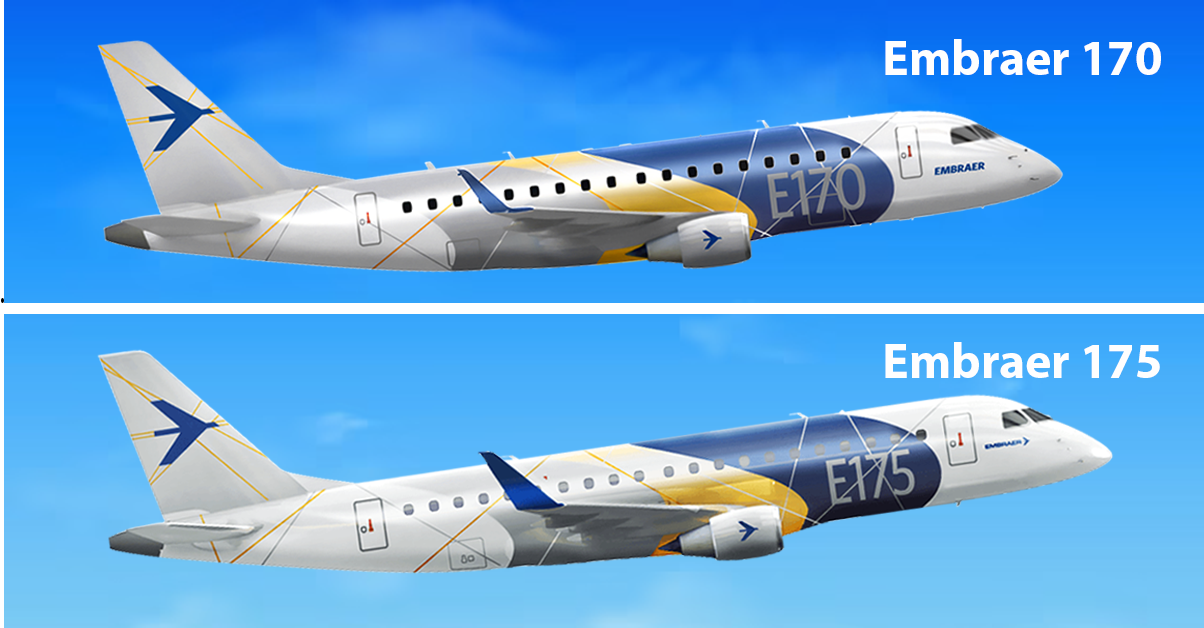Embraer 170 vs Embraer 175: these two regional jets, while part of the same family, cater to distinct segments of the aviation market. The Embraer 170, known for its efficiency in shorter routes, is designed for airlines targeting less dense markets. On the other hand, the Embraer 175, with its slightly increased capacity, bridges the gap between small regional jets and larger aircraft, ideal for growing routes. This comparison highlights their unique features, operational benefits, and the specific airline needs they fulfill.
Embraer 170 vs Embraer 175

The main differences between the Embraer E170 vs Embraer E175 lie in their capacities and performance. The E175 has a higher maximum takeoff weight and landing weight compared to the E170, meaning it can carry more passengers or cargo. Additionally, the E175 typically accommodates more passengers, with configurations offering more seats at various pitch sizes. In terms of performance, while both aircraft have the same maximum cruise speed and service ceiling, the E175 takes slightly longer to climb to its cruising altitude and requires a longer runway for takeoff. However, it offers a slightly longer range compared to the E170, meaning it can fly slightly farther distances without needing to refuel. Overall, the E175 is a larger and slightly more capable aircraft compared to the E170. Check out our comparison Embraer 190 vs 195 of the to see how they differ.
Here’s a comparison table of the Embraer E170 vs Embraer E175 based on the specifications provided:
| Specification | Embraer E170 | Embraer E175 |
|---|---|---|
| Maximum Take Off Weight | 38,600 kg / 85,098 lb | 40,370 kg / 89,000 lb |
| Maximum Landing Weight | 33,300 kg / 73,414 lb | 34,100 kg / 75,178 lb |
| Maximum Payload | 9,743 kg / 21,480 lb | 10,094 kg / 22,253 lb |
| Maximum Usable Fuel^ | 9,335 kg / 20,580 lb | 9,355 kg / 20,580 lb |
| Typical Seat Capacity | ||
| Dual Class | 66 seats (6 @ 40”, 60 @ 32” pitch) | 76 seats (12 @ 36”, 64 @ 31” pitch) |
| Single Class | 72 seats @ 32” pitch | 78 seats @ 33” pitch |
| 88 seats @ 29” pitch | ||
| Performance | ||
| Max Cruise Speed | M 0.82 | M 0.82 |
| Time to Climb to FL350* | 16 min | 18 min |
| Takeoff Field Length** | 1,151 m / 3,776 ft | 1,266 m / 4,154 ft |
| 1,644 m / 5,394 ft | 2,244 m / 7,362 ft | |
| Landing Field Length**** | 1,241 m / 4,072 ft | 1,261 m / 4,137 ft |
| Service Ceiling | 41,000 ft | 41,000 ft |
| Range* | 2,150 nm / 3,982 km | 2,200 nm / 4,074 km |
Embraer 170

The Embraer 170, a trailblazer in the E-Jet family, is designed for regional aviation efficiency. It typically accommodates 70 to 78 passengers, making it ideal for airlines operating on less dense routes. With a range of approximately 2,150 nautical miles, the E170 is well-suited for short to medium-haul flights. Its 2-2 seating configuration in economy class eliminates the middle seat, enhancing passenger comfort. The aircraft’s smaller size allows it to access shorter runways, broadening its operational flexibility. Known for its fuel efficiency and reduced operational costs, the E170 is a popular choice for regional carriers looking to optimize frequency and operational efficiency.
Embraer 175

The Embraer 175, a direct sibling in the E-Jet series, offers a slight stretch over the E170. It can seat between 76 to 88 passengers, providing airlines with a modest increase in capacity for routes experiencing growth. The E175 boasts a similar range to the E170, around 2,200 nautical miles, allowing it to efficiently cover short to medium-haul routes. It maintains the comfortable 2-2 seating arrangement, ensuring a pleasant passenger experience. Despite its increased size, the E175 retains operational efficiency comparable to the E170, with slightly higher operational costs. Its versatility makes it an attractive option for airlines expanding their network within the regional market, bridging the gap between smaller jets and larger narrow-body aircraft.
Design and Comfort
Embraer 170: As the trailblazer of the E-Jet family, the Embraer 170 brought a refreshing change to regional aviation with its focus on passenger comfort and modern design. The cabin’s 2-2 seating configuration, eliminating the middle seat, was a game-changer, ensuring a more enjoyable experience for passengers, especially on shorter journeys.
Embraer 175: Building on the success of the E170, the Embraer 175 stretches the possibilities, quite literally. It mirrors the E170’s design ethos but adds extra length to the fuselage, translating to more cabin space. This subtle yet significant tweak means enhanced comfort and a feeling of spaciousness for passengers.
Capacity and Range
Embraer 170: Seating approximately 70 to 78 passengers, the E170 is the go-to choice for airlines navigating less dense routes. With a range of about 2,150 nautical miles, it’s tailor-made for short to medium-haul flights, offering flexibility and efficiency in operations.
Embraer 175: The E175 takes capacity up a notch, accommodating 76 to 88 passengers. This increase positions it perfectly for routes that are just beginning to burgeon. Its range, hovering around 2,200 nautical miles, ensures it can confidently cover similar distances as the E170, but with a few more seats filled.
Performance and Efficiency
Embraer 170: The E170 shines in operational efficiency. Its size is a strategic advantage, allowing access to smaller airports and shorter runways, broadening the horizon for regional connectivity. The aircraft’s fuel efficiency is a boon, particularly in an era where environmental considerations are paramount.
Embraer 175: The E175 maintains a close grip on the efficiency legacy. Slightly larger, it brings a balance between passenger volume and cost-effectiveness. This aircraft doesn’t just fly; it strategically navigates the fine line between capacity and operational expenses, making it a smart choice for routes on the cusp of growth.
Economic Aspects
Embraer 170: With lower operational costs, the E170 is a budget-friendly powerhouse. It’s an ideal solution for airlines that prioritize frequency over capacity, allowing them to offer more flights without oversaturating the market.
Embraer 175: The E175, with its increased capacity, may incur slightly higher operational costs but opens the door to enhanced revenue opportunities. It’s a strategic asset for airlines looking to incrementally scale their operations on growing routes without a drastic leap in costs.
Role in Airline Fleets
Embraer 170: The E170 is a staple for regional airlines, seamlessly fitting into the puzzle of connecting smaller cities with major hubs. Its role is crucial in markets where frequency and flexibility are more important than capacity.
Embraer 175: The E175 steps up where the E170 leaves off. It’s a natural progression for routes that have matured beyond the capacity of the E170. This aircraft is often the bridge between regional and larger narrow-body operations, embodying growth and adaptability.
Tech Innovations and Future Prospects
Both theEmbraer 170 (E170) and Embraer 175 (E175) are marvels of modern aviation technology. They boast advanced avionics, superior aerodynamics, and efficient engines. As the aviation industry strides towards a more sustainable future, these aircraft continue to evolve, adopting newer technologies and more efficient engines to reduce their environmental impact.
Conclusion
Embraer 170 Vs Embraer 175, though born from the same family, cater to subtly different needs in the regional aviation market. The E170, with its cost-effective operation, is ideal for lower-density, high-frequency routes. On the other hand, the E175 offers an intelligent solution for growing markets, bridging the gap between regional and larger narrow-body services. These aircraft, with their blend of efficiency,
comfort, and adaptability, are not just tools for connectivity; they are catalysts in reshaping the regional aviation landscape. As the industry continues to evolve, the E170 and E175 will undoubtedly play pivotal roles in shaping the future of regional air travel, demonstrating the power of thoughtful design and strategic deployment.
FaQs
What are the main differences between the Embraer E170 vs Embraer E175?
Do the Embraer 170 and 175 have the same range?
Which aircraft is more cost-effective for airlines?
Which aircraft is better for expanding regional networks?



